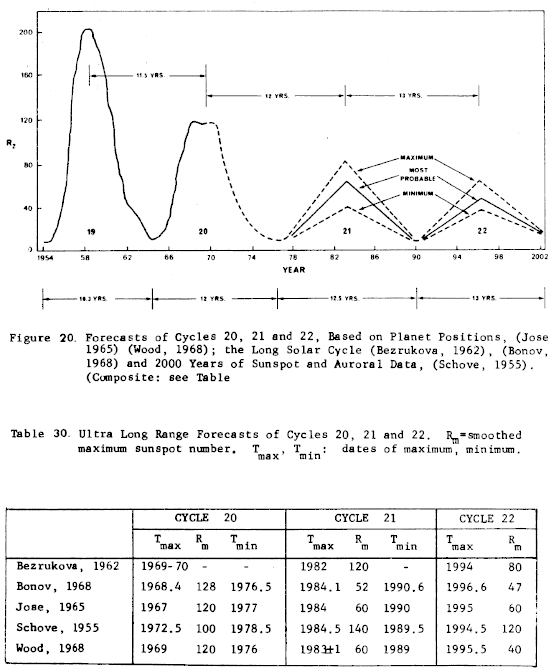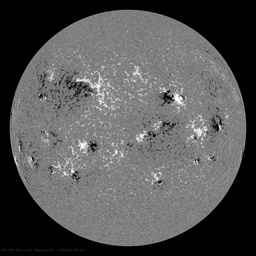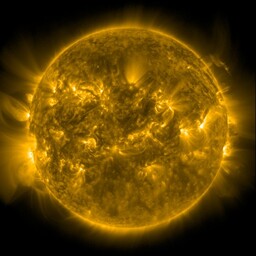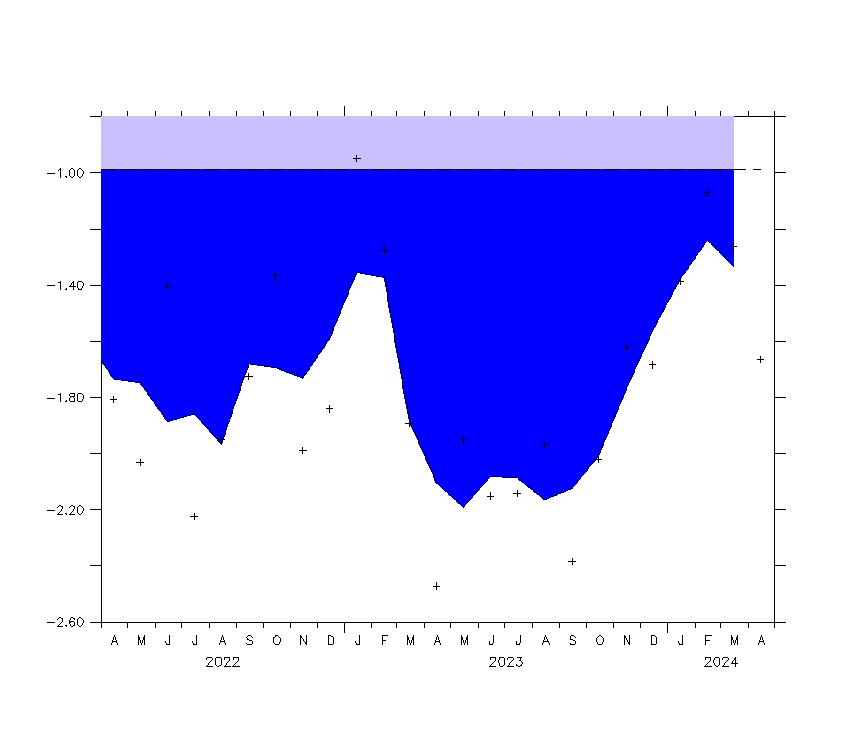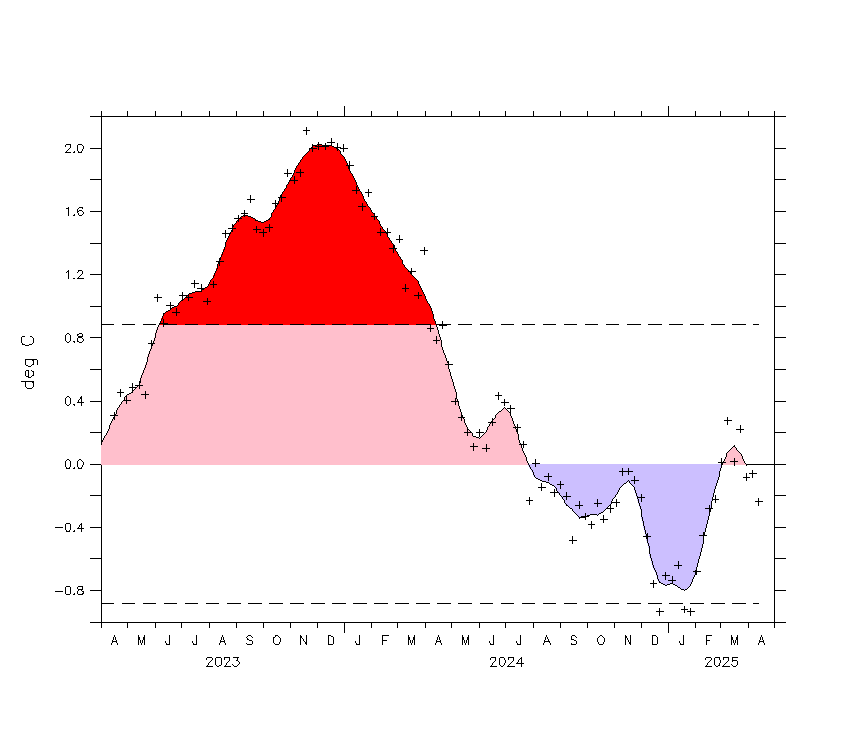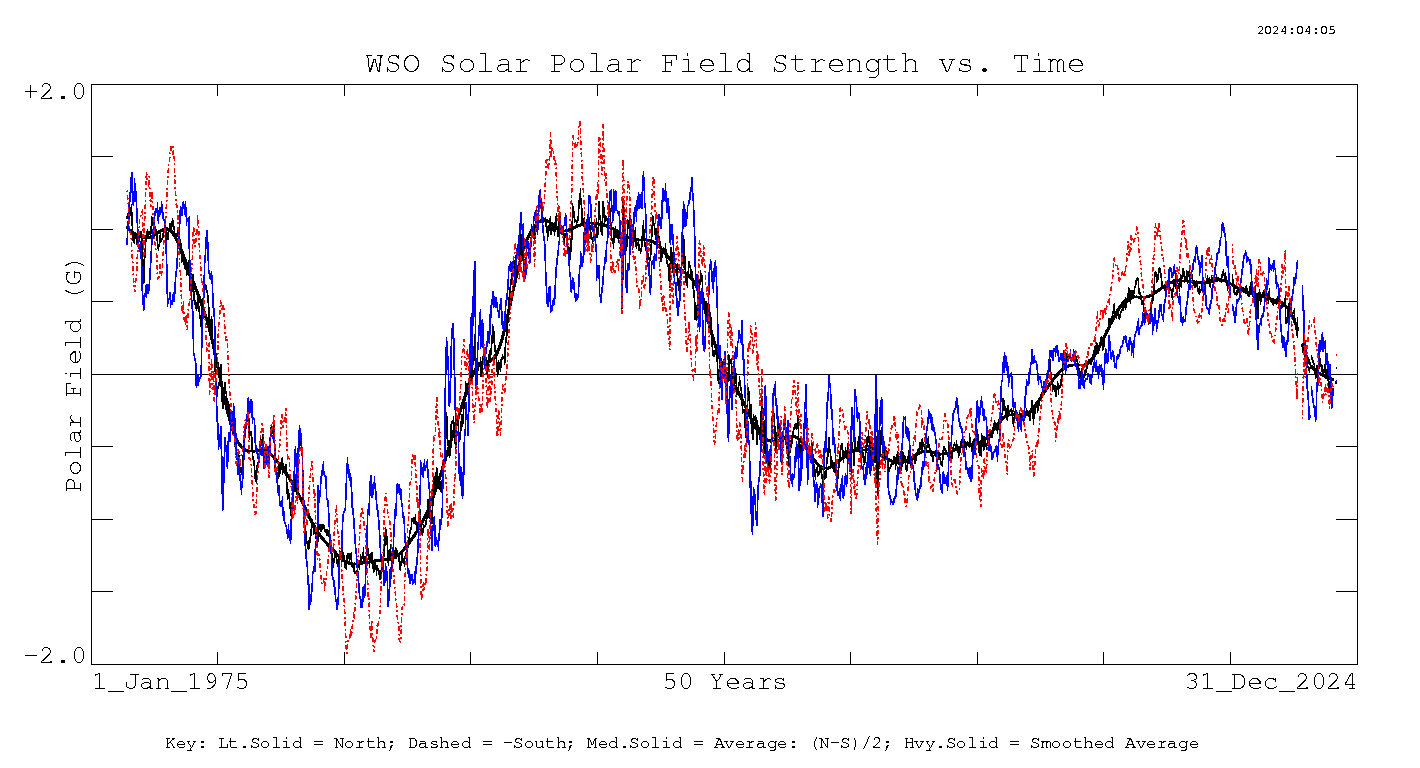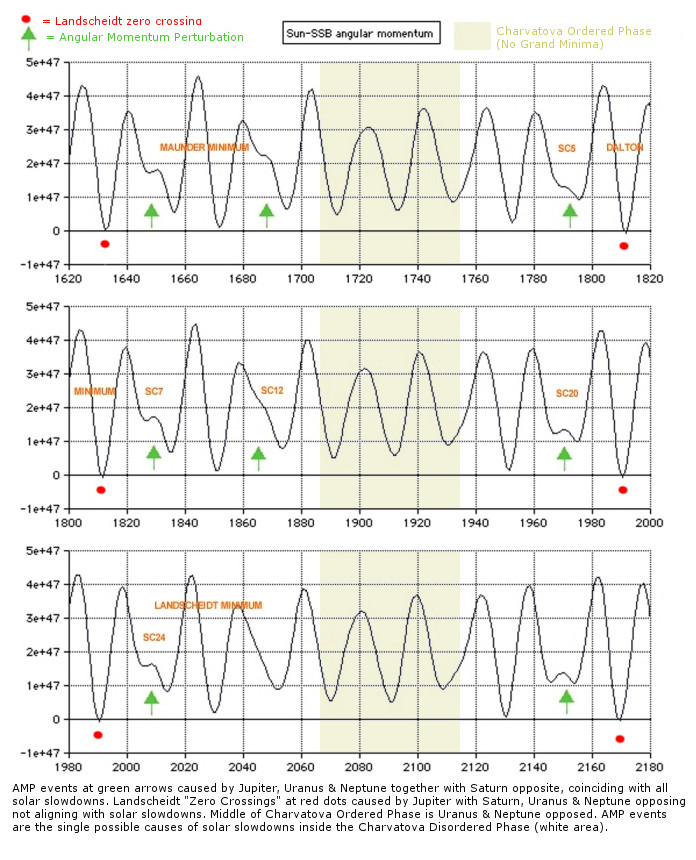
Solar Angular Momentum graph produced by the late Carl Smith 2007. Annotations and green arrows added.
Planetary influence over solar cycle output and solar grand minima has been theorized since the early days of Rudolf Wolf. Jose was the first to gain traction in 1965 and was then followed by major players Landscheidt, Fairbridge and Charvàtovà who published many papers but were never really taken seriously by the scientific public at large. All the aforementioned authors have made solid contributions to this valuable area of research and without this base knowledge I am sure the late Carl Smith would never have had the motivation to produce his soon to be famous (I believe) solar angular momentum graph (2007).
In my opinion Charvàtovà had the most to offer where she picked up on the Jose SIM diagram that displayed the irregular orbit pattern of the Sun around the solar system barycentre (SSB). She noticed that during times of grand minima the orbit pattern changed which is a major break through and now with the added data from Carl we can now understand and quantify this change, but more on that later.
Jose believed there was a recurring 179 year pattern that controlled the Suns orbital path around the SSB, this was the original discovery that recognized the returning SIM pattern that controls our Sun. While he was in the ballpark we now know through Carl's graph and JPL data that this pattern is indeed very loose but none the less there is a recurring occurrence of grand minima over the Holocene that centres around the synodic period of Uranus and Neptune (171.4 years) but this can only be used as a rough guide and is not capable of predicting grand minima down to the solar cycle like we can today.
Landscheidt wrote many papers and a book which covered planetary harmonics and their interconnection with solar and Earth functions which included ENSO, atmospheric teleconnections, lake levels, fish and animal populations as well as the stock market. His most famous prediction was for a solar grand minimum between 1990 and 2070 which would peak at 2030 in his book Sun-Earth-Man (1989). Landscheidt used one single dataset to produce this forecast which follows the solar torque readings that result from the changing solar orbit shape directly influenced by the planet positions. Once again he was in the ball park but I believe through Carl's graph we can now drill down much further to reveal a far higher level of accuracy when looking at each solar cycle, when we do this Landscheidt's predictions I think will prove to be out of place. Below are two graphs that Landscheidt used to form his prediction.
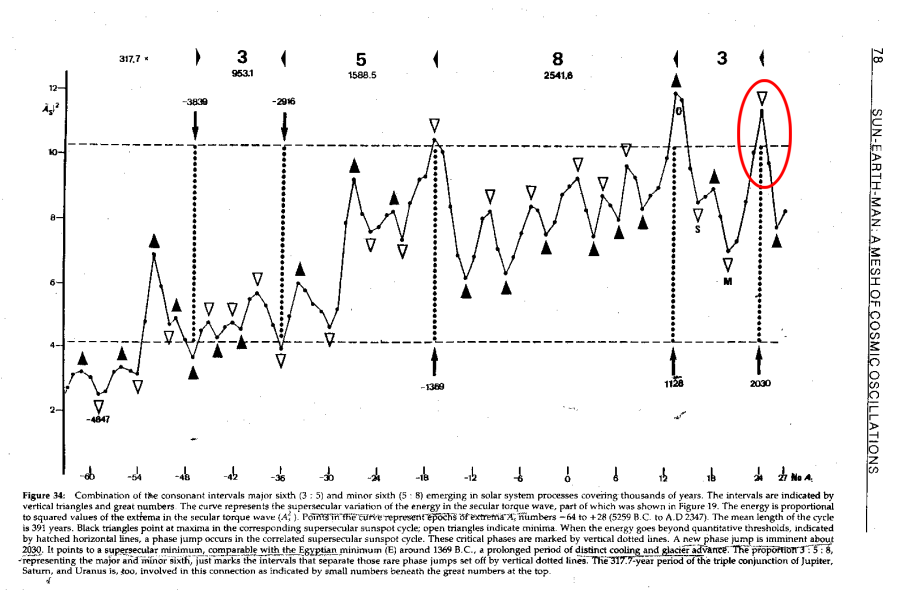
Taken form Sun-Earth-Man pg 78 showing the torque curve that Landscheidt used for his prediction. The Landscheidt torque curves vary wildly from the standard AM curves. Note there is no torque extrema during the Little Ice Age. Click for a larger view.
The following is the excerpt from his book where his prediction is first noted.
"When subsets are formed, the results prove to be homogeneous. The torque wave
points to a secular sunspot minimum past 1990.
The extrema in the secular wave of IOT can be taken to constitute a smoothed
supersecular wave with a quasi-period of 391 years. This long wave points to
an imminent supersecular sunspot minimum about 2030. There are
indications that secular and supersecular sunspot minima are related to
variations in climate. Thus a prolonged period of colder climate is about to be
initiated by the secular minimum past 1990, will reach its deepest point around
the supersecular minimum in 2030, and come to an end about 2070. "
In a later paper Landscheidt uses a different torque graph to reinforce his 2030 prediction but now moves away from the 1990 prediction which of course did not occur. The following is taken from a comment I published 3 years ago on this site.
Here is the original graph that Landscheidt used in his predicted 1990 and 2030 grand minimum. The red dots highlighting those years. Also included is his original text showing his reasoning. The level of detail between his data and Carl's is many orders different, but you can see the general trend in the past followed roughly by grand minima. When the AM or torque dips below the dotted line there is a solar slowdown, but he is just picking up markers that occur around the same time and not seeing the actual driver. Note that Landscheidt predicts this grand minimum to be of a similar strength and timing as the Maunder....I wonder what he would think now, if he were still with us today?

Fig. 11:Time series of the unsmoothed extrema in the change of the sun's orbital rotary force dt for the years 1000 – 2250. Each time when the amplitude of a negative extremum goes below a low threshold, indicated by a dashed horizontal line, a period of exceptionally weak solar activity is observed. Two consecutive negative extrema transgressing the threshold indicate grand minima like the Maunder minimum (around 1670), the Spoerer minimum (around 1490), the Wolf minimum (around 1320), and the Norman minimum (around 1010), whereas a single extremum below the threshold goes along with events of the Dalton minimum type (around 1810 and 1170) not as severe as grand minima. So the Gleissberg minima around 2030 and 2200 should be of the Maunder minimum type. As climate is closely linked to the sun's activity, conditions around 2030 and 2200 should approach those of the nadir of the Little Ice Age around 1670. As explained in the text, the IPCC's hypothesis of man-made global warming is not in the way of this forecast exclusively based on the sun's eruptional activity. Outstanding positive extrema have a similar function as to exceptionally warm periods like the Medieval Optimum and the modern warm period.
Landscheidt is using torque extrema that occur when Saturn/Uranus and Neptune line up with Jupiter opposing. During this event the Sun returns very close to the SSB (red crosshairs).
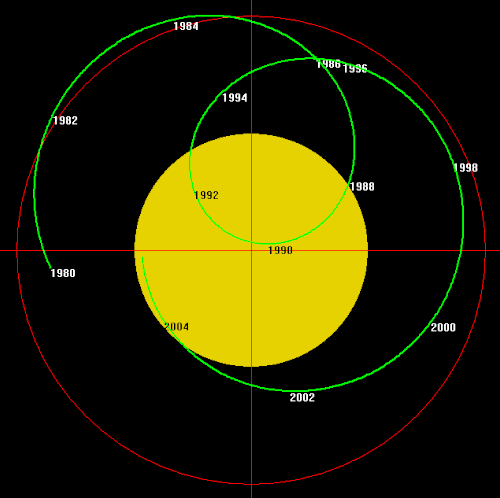
This is where the Landscheidt marker is close to where grand minima occur but unfortunately is very vague. The marker can only occur near a Uranus/Neptune conjunction which is also what is required to trigger the angular momentum perturbations (AMP event) shown via the green arrows in Carl's graph, but the conjunction can be decades away from the AMP event and can produce erroneous predictions. The current event should be short and weak like the Dalton Minimum and the 2200 event will also be weak if we follow Carl's graph which has successfully predicted the current grand minimum and hindcast grand minima throughout the Holocene.
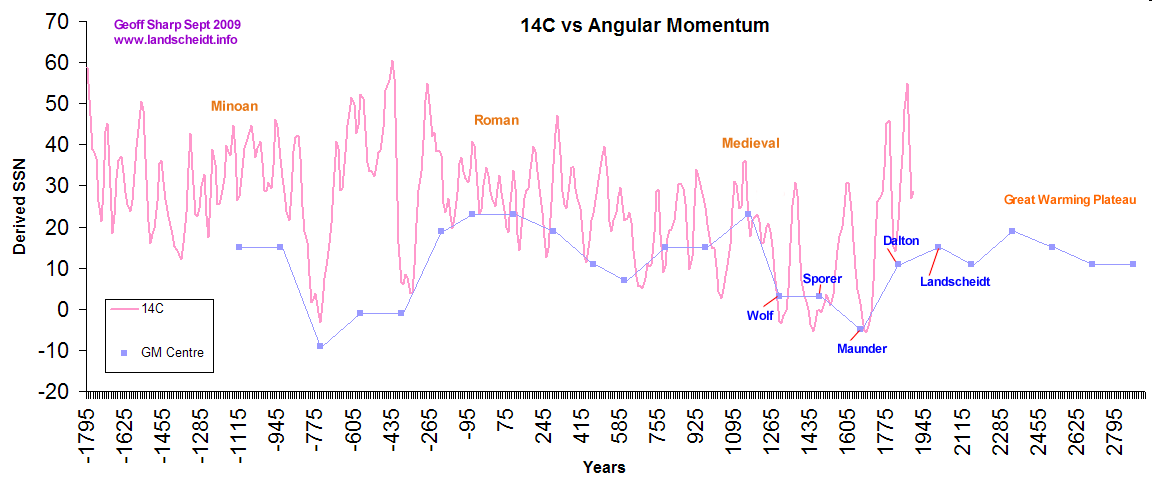
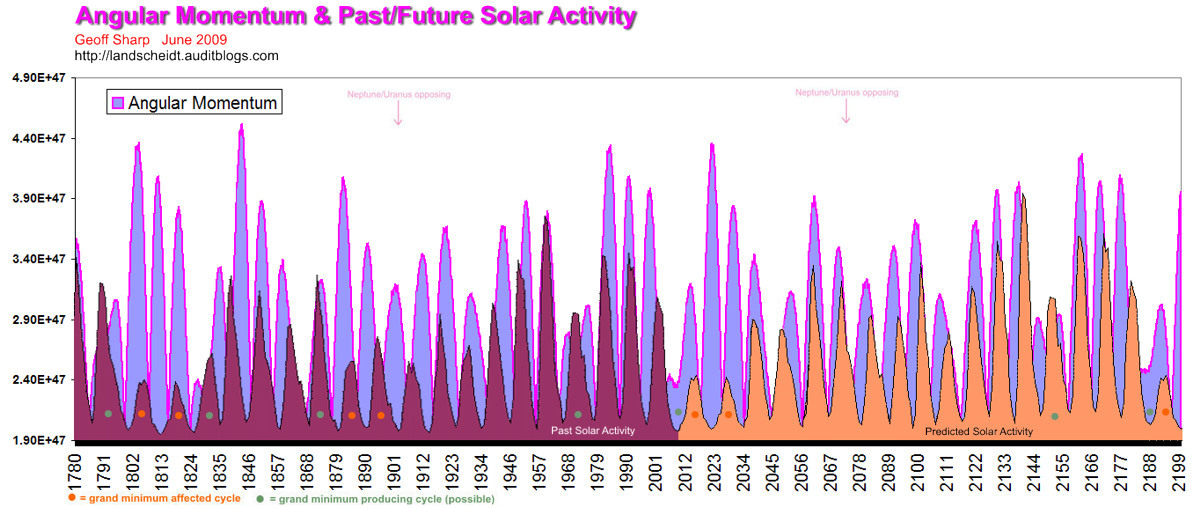
Solar cycle prediction based on angular momentum (AM). AM is important for overall cycle strength and solar grand minima.
There is much research on the AMP events on this website and I suggest a good place to start is the "Published Paper" link at the head of this site.
Further evidence of Landscheidt's prediction of a 1990 solar grand minimum is observed in his 1981 paper "Swinging Sun, 79-Year Cycle, and Climatic Change" where he states;
"As to practice, it seems possible now to calculate the date, the phase, and the amplitude of long-term solar variations in past and future. It is no longer necessary to recur to ultralong cycles with a duration of hundreds or thousands of years. The irregular distribution of the rare impulses of the torque of great strength offers a simpler explanation of ultralong-term variations. Fig. 4 shows the future course of the 79 YC. The next negative RDM will be released in 1990. It meets the criterion Cn2. The amplitude can be assessed by the Sit-value which is equal to| 4.23| U. The minimum about 1811 reached only 2It =| 4.07| U. Relatively small differences in the 2It-data lead to relatively great differences in the amplitudes. This can be seen from Table 2. Thus it may be expected that the negative RDM 1990 will be distinctly more pronounced than the 1811-minimum........It is to be expected that the climatic conditions in at least three decades after 1990 will be more severe than after 1811 as corresponds to the ratio 2 lt = |4.071 U(RDM 1811) toSlt =|4.23| U (RDM 1990) compared with 2 |t = l 4.43| U (RDM 1671)"
Of interest Fairbanks predicted a 1990 solar grand minimum using the same zero crossing method and Jose cycle as Landscheidt. Below is an excerpt from Fairbridge's 1987 paper.
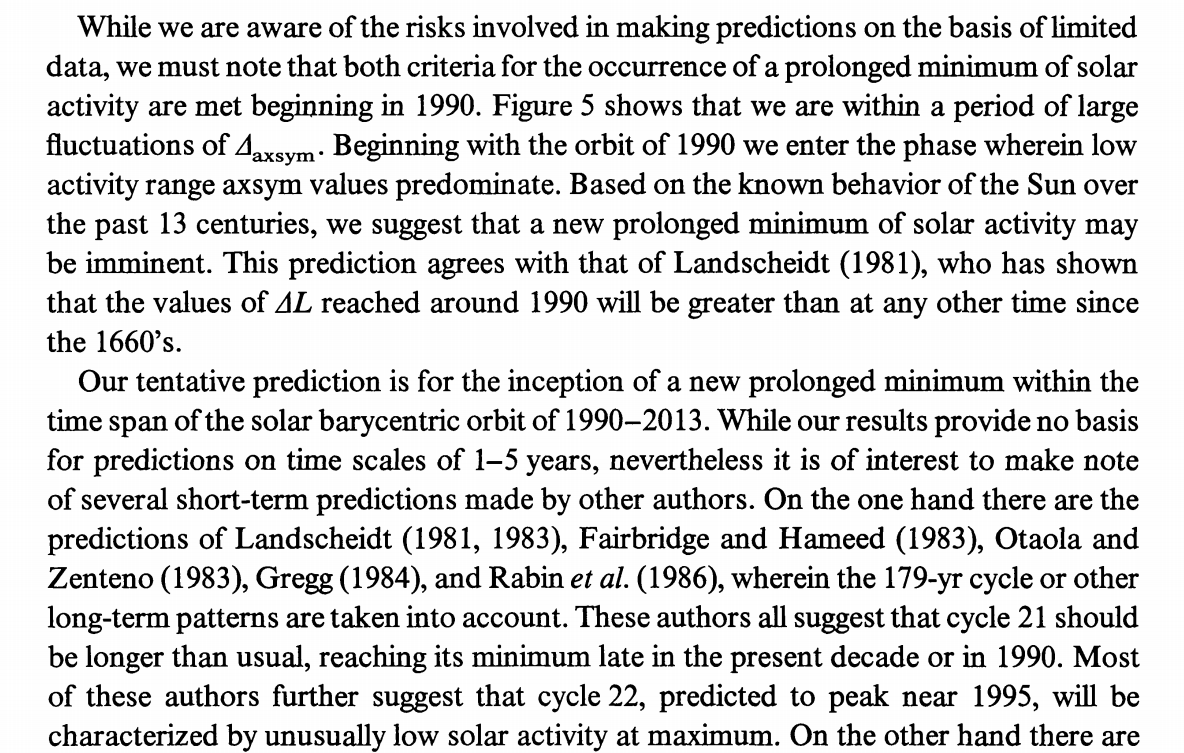
I think it is pretty clear that although Landscheidt and Fairbridge are on the right track their failed predictions show there is something missing in their base theory. It is also interesting that Landscheidt did have similar data that is presented in Carl's graph but he failed to recognize the significance. In his 1989 book on pg 16 he states:
"As has been shown already, the Sun's surface is a boundary in terms of the
morphology of nonlinear dynamic systems. Thus, it makes sense that the
major instability events starting about 1789, 1823, and 1867, and later about
1933 and 1968, occurred just when the centre of mass remained in or near the
Sun's surface for several years.
When the Sun approaches the centre of mass (CM), or recedes from it, there
is a phase when CM passes through the Sun's surface. Usually, this is a fast
passage, as the line of motion is steeply inclined to the surface. There are rare
instances, however, when the inclination IS very weak, CM runs nearly
parallel with the Sun's surface, or oscillates about it so that CM remains near
the surface for several years. Fixing the epochs of start and end of such periods
involves some arbitrariness. The following definition is in accordance with
observation and meets all requirements of practice: major solar instability
events occur when the centre of mass remains continually within the range
0.9 - 1.1 solar radii for 2.5 to 8.5 years, and additionally within the range 0.8
- 1.2 soIar radii for 5.5 to 10 years. The giant planet Jupiter is again involved.
In most cases major instability events are released when Jupiter is stationary
near CM.
The first, sharper criterion yields the following periods:
1789.7 - 1793.1 (3.4 yr)
1823.6 - 1828.4 (4.8 yr)
1867.6 - 1870.2 (2.6 yr)
1933.8 - 1937.3 (3.5 yr)
1968.4 - 1972.6 (4.2 yr)
2002.8 - 2011.0 (8.3 yr)
The first decimal is only given to relate the results rather exactly to the aiterion.
The epochs of the onset and the end of the phenomenon cannot be assessed
with such precision. The second, weaker criterion yields periods which begin
earlier:
1784.7 - 1794.0 (9.3 yr)
1823.0 - 1832.8 (9.8 yr)
1864.5 - 1870.9 (6.4 yr)
1932.5 - 2938.3 (5.8 yr)
1967.3 - 1973.3 (6.0 yr)
2002.2 - 2011.8 (9.6 yr)
Henceforth, the starting periods 1789, 1823 etc. of the first criterion will be
quoted.
In case of major instability events that affect the Sun's surface and the
incidence of features of solar activity displaying in this thin, sensitive layer
the instability seems to spread out in the planetary system and seize all events
in time series that are connected with the Sun's activity."
When Landscheidt talks of major instability events he is NOT referring to solar output, but instead he is using this event as a place in time where phase reversals occur. ie where he uses the minima instead of maxima of extrema in the particular dataset he is employing. The major instability events according to Landscheidt affect rise and fall of animal populations, economic turning points, stock prices, interest rates, global periods of general instability and even human creativity, later he associated the PTC event with changes to the ENSO pattern. Landscheidt in later papers moves away from these less than scientific statements but at no point associates these events with reduced solar output.
And in another graph I highlighted 3 years ago:
I found another graph that Landscheidt uses in "Solar Eruptions Linked to North Atlantic Oscillations" that shows that he DID have access to information at a more precise level. Here he shows the "camel humps" like we see in Carl's AM graph but this graph is based on torque measurements (which are similar to AM). Landscheidt calls these perturbations PTC (perturbed torque curve) and he states that they occur every 35.8 years, and are responsible for "phase reversals". My research and Carl's suggest the PTC type disturbance does not occur on a repeating pattern, but only when Neptune & Uranus are in or near conjunction. This I think is further evidence that Landschiedt perhaps missed this vital piece of the puzzle???? 
Landscheidt used many planetary cycles to compare with solar and earth cycles. In particular he employed the alignment between the Sun/SSB and Jupiter (see update below). What he found was that the correlations went out of phase over time but invoked a phase reversal so that he could use both minima and maxima of a given cycle. He uses the PTC event (major stability event) which is the same as the green arrows on Carl's graph as a position for phase reversal but completely misses that these events are what correlate with all solar slowdowns and the altered solar path that Charvàtovà made her name on. He incredibly was so close, but unfortunately no cigar.
In a recent article Roger Tattersall (tallbloke's talkshop) on his blog that is predominately focused on planetary theory makes the mistake of stating that Landschiedt uses the PTC type or major instability events to predict solar slowdowns, this is obviously incorrect. I have tried to inform him of his error but to date he is reluctant to change his incorrect and misleading views.
This is where we pick up on Charvàtovà. In the 1988 she produced a paper "The Relations Between Solar Motion and Solar Variability" showing that grand minima occur when the solar orbit is disordered over longer periods. All past grand minima have shown a correlation with this disordered pattern about the SSB so she is definitely on the ball but sadly does not continue her research into the ultimate reasons for the disordered orbit. She hints that the conjunction of Uranus and Neptune are at the centre of grand minima epochs like Landscheidt but fails to drill down to the underlying causes or how each disordered orbit can be quantified in relation to the strength of a solar slowdown.
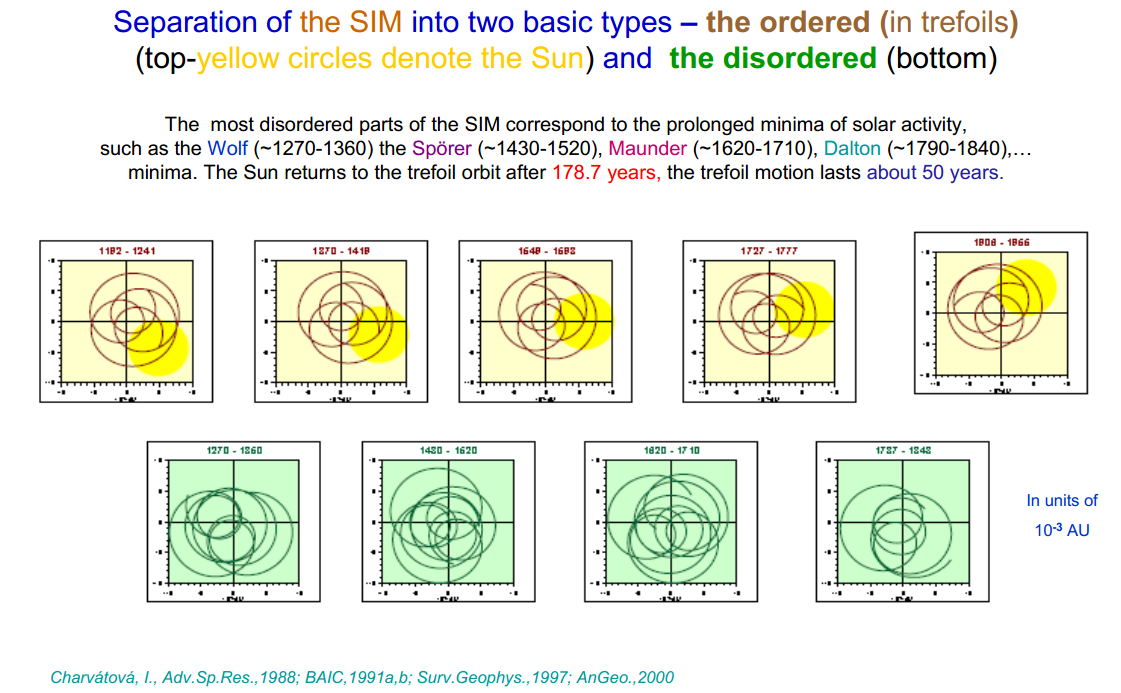
In 1988 she predicts a period of lower sunspot activity and longer cycles from 2000-2030 and the epoch will be more Dalton like which is more accurate than Landscheidt (if my predictions pan out) but she does not see the planet position of Jupiter/Uranus/Neptune with Saturn opposing that individually creates the disordered solar pattern. Her later papers and slide shows also display this omission. Her 2000 paper describes a period of disordered orbit from 1985-2030 but she missed the disordered orbit at 1970 which coincides with the low solar cycle SC20.
UPDATE: In 2007 Charvàtovà produced a paper that predicts SC24/25/26, she wrongly suggests this period will be the same as SC11/12/13 and predicts a SSN of 140 for SC24 and a cycle max of 2010. Unfortunately after 20 years of her initial discovery no progress was made and if anything adds to the growing bad predictions made by the pioneers that today make it harder to progress in this field, but without the mistakes we would not have Carl's graph.
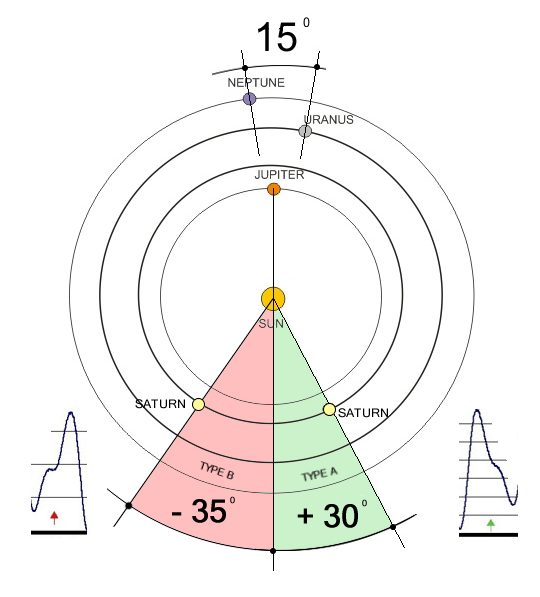
The above planet sequence is the main driver of the disordered pattern that happens either side of the U/N conjunction. Below is an image of how the solar orbit varies (green line)
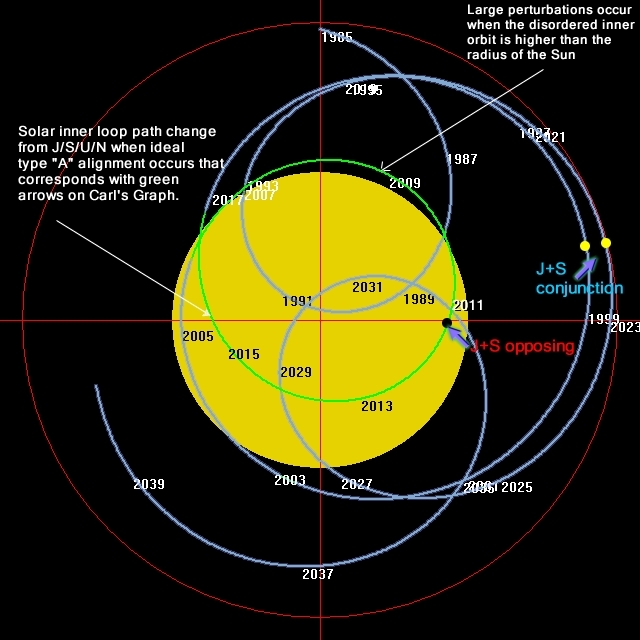
The green arrows on Carl's graph align with the above planetary position and the altered green orbit path. The main disruption only occurs during the inner loop but looking at the shape of the loop alone does not give enough detail to distinguish a low cycle from a grand minimum type cycle. The altered path of 1970 does not look all that different to the current path but there should be quite some difference between SC20 and SC24 in terms of solar output. This is where Carl's graph comes in and we can quantify the AMP event that happens at the green arrows. I have tried to contact Dr. Charvàtovà without success, but I am sure she would be interested to see the relevance of Carl's graph in relation to her work.
Carl was not aware of his discovery when he created the graph and sadly when I pointed it out to him he was happy but had other matters on his mind, as you would expect when suffering from terminal cancer. Carl rewarded me by passing on his blog to me and Carl's brother David has sponsored me in the hope of furthering Carl's work. I consider myself lucky to have stumbled on Carl's graph which I will endeavour to push as the rosetta stone of solar science.
Unfortunately todate no one in the science arena has picked up on this discovery which was first published online in 2008, the topic is banned at WUWT (the largest science forum on the web) and so far has been largely ignored by planetary forums including Tallbloke's Talkshop. Hopefully this will change in the future when the large amount of information is gradually absorbed and the predicted solar grand minimum takes hold. Update 10/04/15: In 2014 McCracken, Beer and Steinhilber publish a paper in Solar Physics that includes all my basic principles in regard to solar grand minima.
Update 28/04/2012: The lineups of Jupiter, Sun and SSB that Landscheidt refers to many times in several papers are the peaks and troughs observed in Carl's graph. I used a program (SIM2 Arnholm) to precisely document these occurrences. Of interest (and I don't think noticed by Landscheidt) is that during AMP events at the green arrows this alignment can last up to 10 years as the SSB acts as a pivot point with the Sun & Jupiter rotating around this point maintaining the alignment. Landscheidt as stated used this as a boundary change between phases and does not associate the solar downturn that occurs during this event, I think his preoccupation with Mandlebrot sets and Astrology blurred his vision, not enabling him to see the fundamental process occurring at the Sun that is obvious today. His need to find boundary conditions that enabled phase change was stronger than observing solar output.
Update 10/04/2015: Thanks to Tim Channon from tallblokes blog for providing a link to the papers of Blizard and Wood who produced a lot of planetary papers in the sixties which I have been looking for. Basically there is 186 pages of complete nonsense that has gone a long way towards maligning planetary science, but I guess if the basic interest was not there back in the day we would not be here today.
Of great interest is a graph or prediction for cycles SC21 and SC22 from Jose and Wood created during SC20. The prediction was obviously far from correct showing they were both on the wrong track.
